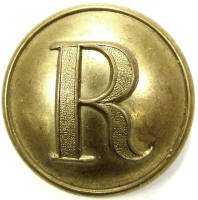
A virtual examination of artifacts of the American Civil War
by Harry Ridgeway
 |
Ridgeway Civil War Research Center, A virtual examination of artifacts of the American Civil War |
| Civil War Artillery | |
by Harry Ridgeway |
| Rifled artillery projectile, Dyer design, Federal manufacture, bursting shell, "common" (standard), rounded nose, lead cup sabot, without flame grooves, Schenkl rounded head percussion fuze early pattern, Ordnance rifle, 3in. Projectile was manufactured in the Federal arsenals following the invention of Alexander Dyer. The sabot system >utilized was an expanding lead cup around the base This pattern features the sabot with a concave bottom, and a groove around the top, no flame grooves were cut into the sabot, this came later. Nose of the shell is rounded, the sabot on this early pattern has iron straps imbedded on the bottom, probably to secure the powder bag. Some of these shells were configured as case shot (approx 10lbs to 11lbs . with balls ), or as "common" (approx 8lbs. to 9lbs. without balls). This shell is a "common" shell, (standard), it does not contain balls, and with a percussion fuze it was designed to detonate after striking enemy cannon or equipment. Fuze employed was a Schenkl brass percussion fuze, early version with rounded flange, Jones pg. 98 lower right. Projectile measures: diameter 2. 94in., length 7in. (excluding fuze), weight 8lbs. to 9lbs. Research Center: Artillery4012-Dyer, Ref: Dickey & George, Field Artillery (1993 Edition), pg. 144. Details click: http://relicman.com/artillery/Artillery4012-Dyer.html. |
| Ridgeway Civil War Research Center, A virtual examination of artifacts of the American Civil War. Artillery Research center, artillery, click: http://relicman.com/artillery/Artillery0000-Index.html. Research center, artillery, click: http://relicman.com/artillery/Artillery0000-Index.html. |
| Civil War Relicman, Harry Ridgeway, Civil War artillery, Relicman sales catalog. Click here: http://relicman.com/artillery/RelicmanSalesArtillery1.html. Artillery for sale: http://relicman.com/artillery/RelicmanSalesArtillery1.html. |